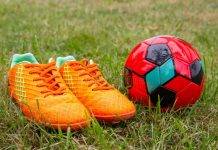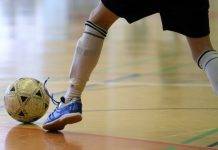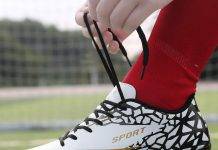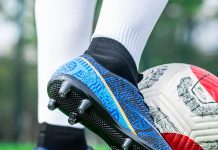Sure, we all know that soccer is an exhilarating sport that brings out the competitive spirit in both kids and adults alike. But when it comes to gearing up for the game, one question that often arises is whether kids can play soccer without cleats. After all, not every child may have access to or be able to afford a pair of cleats. In this article, we will explore the pros and cons of playing soccer without cleats, examining the impact it has on a child’s gameplay, safety, and overall performance. So, lace up your boots and join us as we discover if kids can conquer the soccer field without those trusty cleats.
Benefits of wearing cleats
Playing soccer with cleats offers several advantages for players.
Review contents
Improved traction
One of the key benefits of wearing cleats is the improved traction they provide. Cleats have specialized studs or spikes on the sole that help players grip the ground effectively. This enhanced traction allows players to make quick turns, sudden stops, and explosive movements with confidence, minimizing the risk of slipping or losing balance.
Preventing slips and falls
Cleats help to prevent slips and falls on wet or muddy surfaces. The studs or spikes on the sole penetrate the ground, providing stability and preventing players from sliding. This is especially important in outdoor games where weather conditions can be unpredictable. By wearing cleats, players can maintain their balance and focus on the game, reducing the likelihood of injuries caused by accidental falls.
Better control
With cleats, players can experience better control over the ball. The studs or spikes on the sole dig into the ground, allowing players to plant their feet firmly and exert greater force while kicking or dribbling. This added control improves passing accuracy, shooting power, and overall ball-handling skills. Cleats also provide a larger striking surface and enhance players’ ability to manipulate the ball, giving them a competitive edge on the field.
Reduced risk of injury
Cleats play a crucial role in reducing the risk of soccer-related injuries. The improved traction and stability they provide minimize the chances of slipping, reducing the risk of ankle sprains, twisted knees, or other lower limb injuries. By ensuring better control and grip on the ground, players are less likely to make sudden awkward movements that could lead to muscle strains or ligament tears. Wearing cleats that fit properly and provide adequate support can significantly contribute to injury prevention in soccer.
Safety concerns without cleats
While it is technically possible to play soccer without cleats, there are several safety concerns that arise when players choose to forego this important piece of footwear.
Increased risk of slipping
Without the traction provided by cleats, players are at a higher risk of slipping and losing balance on the field. This is especially true when playing on wet or uneven surfaces. Slipping can result in falls, collisions with other players, or even collisions with the ground itself, which can lead to injuries such as bruises, sprains, or fractures. The absence of cleats decreases players’ ability to effectively grip the ground, making it more challenging to perform quick movements without compromising their safety.
Limited control
Playing soccer without cleats can severely limit a player’s control over the ball. The smooth sole of regular athletic shoes or sneakers does not provide the same level of grip and traction as cleats. This can make it difficult for players to maneuver and manipulate the ball effectively, impacting their passing accuracy, shooting power, and overall performance on the field. Limited control can also make it more challenging to respond quickly to changing game scenarios, potentially resulting in missed opportunities or defensive vulnerabilities.
Higher chance of injury
Without the support and stability offered by cleats, players face an increased risk of injury. The lack of specialized studs or spikes on regular athletic shoes or sneakers hinders players’ ability to maintain balance and stability during high-intensity movements. This puts additional stress on their muscles, tendons, and ligaments, making them more susceptible to strains, sprains, or other soft tissue injuries. The absence of cleats may also lead to improper foot positioning or excessive pressure on certain areas, increasing the chance of foot or ankle injuries.
Playing on different surfaces
Soccer games are played on various surfaces, including natural grass, artificial turf, or indoor courts. Each surface provides unique challenges and requires specific footwear to ensure optimal performance and safety. Without cleats, players may find it challenging to adapt to different surfaces effectively. For instance, playing on natural grass without cleats could result in slipping or difficulty generating enough traction. Similarly, playing on artificial turf without appropriate footwear can lead to inadequate support or discomfort. Having the right footwear, such as cleats, provides players with the necessary grip and stability to perform at their best on any given surface.
When cleats may not be necessary
While cleats offer numerous benefits, there are certain situations where wearing cleats may not be necessary.
Playing on indoor soccer fields
Indoor soccer fields are typically made of synthetic surfaces designed to mimic the feel of natural grass. These surfaces often have a rubberized or carpet-like texture that provides sufficient traction without the need for cleats. In indoor soccer, where the game is played at a faster pace with reduced chances of slipping, players can opt for indoor soccer shoes instead of cleats. Indoor soccer shoes have a flatter sole without studs or spikes, allowing players to maneuver easily without damaging the indoor surface.
Playing on turf surfaces
Turf surfaces, commonly found in outdoor sports complexes, utilize artificial grass with longer fibers and a rubberized infill. Unlike natural grass, turf surfaces do not require cleats for enhanced traction. The rubberized infill provides sufficient grip, allowing players to maintain their balance and control without the need for studs or spikes. Turf shoes, which have small, rubberized studs or bumps on the sole, are specifically designed for these surfaces and offer better support and stability compared to regular athletic shoes.
Informal games and practice sessions
When playing informal games or engaging in practice sessions, especially in non-competitive or recreational settings, players may not necessarily need to wear cleats. In such situations, where the emphasis is more on fun and participation rather than performance, players can opt for athletic sneakers or rubber-soled shoes. These types of shoes provide adequate comfort and basic traction for casual play but may not offer the same level of control and injury prevention as cleats in more intense or official matches.
Alternatives to cleats
For situations where cleats may not be necessary or suitable, there are several alternative footwear options that players can consider.
Turf shoes
Turf shoes are specifically designed for playing on artificial turf surfaces. They feature a specialized sole with short rubber studs or bumps that provide traction and grip on turf without damaging the surface. Turf shoes offer better support and stability compared to typical athletic shoes, making them a suitable alternative when playing on turf fields.
Indoor soccer shoes
Indoor soccer shoes have a flatter sole compared to cleats, allowing for better maneuverability on indoor surfaces. They are designed to provide adequate grip and traction on synthetic indoor soccer fields, which typically do not require the use of cleats. Indoor soccer shoes offer improved control and comfort, making them a popular choice for indoor games.
Rubber-soled shoes
Rubber-soled shoes, such as athletic sneakers or cross-training shoes, can be a viable alternative to cleats in certain casual or recreational soccer settings. While they may lack the specialized traction and support that cleats provide, rubber-soled shoes offer basic grip and comfort. They are suitable for situations where the focus is primarily on enjoyment and minimal performance demands.
Athletic sneakers
Regular athletic sneakers can also be used as an alternative to cleats, particularly in non-competitive or non-professional soccer games. While they may not provide the same level of traction and control as cleats, athletic sneakers offer adequate comfort and versatility for casual play. Their cushioned soles and breathable materials make them a popular choice for players looking for a more relaxed and flexible approach to soccer.
Factors to consider when choosing alternatives
When deciding on an alternative to cleats, there are several factors to consider in order to ensure the best choice for each player’s specific circumstances and needs.
Surface type
Consider the type of surface you will be playing on. Different surfaces require different footwear to provide the necessary grip and performance. Determine whether you will be playing on natural grass, artificial turf, indoor courts, or other surfaces, and choose footwear that is specifically designed for that surface.
Weather conditions
Take into account the weather conditions during your game or practice session. If there is a likelihood of rain, ensuring proper footwear with adequate traction becomes even more important to prevent slipping or losing control on wet surfaces. Consider footwear that provides enhanced grip and water resistance when playing in areas with unpredictable weather.
Player’s skill level
Consider the skill level and experience of the player. Beginner players may require footwear with more stability and support, while more advanced players who are accustomed to the game’s demands may opt for footwear that offers better control and responsiveness. Choosing footwear that suits the player’s skill level can enhance their overall performance and development.
Budget
Consider your budget when selecting alternative footwear. Cleats can range in price depending on brand, design, and materials. While top-quality cleats may offer the best performance and durability, there are more affordable options available that still provide acceptable levels of traction and support. Set a budget and explore alternatives within that range to find the best balance between cost and quality.
Parents’ concerns about cleats
As parents, there may be certain concerns regarding the use of cleats for young soccer players. Addressing these concerns can help parents make informed decisions about their child’s footwear.
Additional expense
One common concern is the additional expense of purchasing cleats. Parents may worry about the cost, especially considering that young children may outgrow their shoes quickly. However, it is important to recognize that cleats are an investment in both performance and safety. A good pair of cleats with proper fit and quality construction can last the entire season or even longer, providing adequate support and traction for the child’s growing feet.
Limited use
Parents may also worry that purchasing cleats will make them less versatile compared to regular athletic shoes. While it is true that cleats are designed specifically for soccer and certain field sports, their benefits in terms of traction, control, and injury prevention outweigh the limited use. Encourage parents to consider the safety and performance advantages cleats provide on the soccer field, even if they may not be suitable for everyday wear.
Potential for discomfort
Some parents may express concerns about the potential discomfort cleats could cause their child. While it is essential to ensure proper fit and break-in new cleats gradually, modern cleats are designed with comfort in mind. Many models feature cushioned insoles, breathable materials, and adjustable closures to provide a snug but comfortable fit. Encourage parents to choose well-constructed cleats from reputable brands and to consult with knowledgeable sales associates to find the best option for their child’s foot shape and size.
Importance of proper footwear in soccer
Proper footwear is essential in soccer, as it directly impacts performance, safety, and the development of soccer skills.
Enhanced performance
The right footwear, such as cleats, can greatly enhance a player’s performance on the soccer field. The improved traction and control provided by cleats enable players to execute precise movements, including rapid changes in direction, quick turns, and powerful shots. With enhanced grip and stability, players can optimize their speed, agility, and overall playing technique. Cleats also provide a larger striking surface, enabling players to make cleaner and more accurate contact with the ball, resulting in more powerful shots and controlled passes.
Improved safety
Wearing appropriate footwear, such as cleats, significantly improves safety on the soccer field. By providing better traction and stability, cleats help prevent slips, falls, and potential collisions that can lead to injuries. Cleats support the ankles and provide extra cushioning and shock absorption, reducing the risk of sprains or more severe injuries. Additionally, proper footwear ensures proper foot alignment, reducing the strain on muscles, tendons, and ligaments, minimizing the possibility of overuse or repetitive motion injuries.
Development of soccer skills
Proper footwear plays a vital role in the development of soccer skills, particularly in younger players. Cleats enhance a player’s ability to manipulate and control the ball, allowing for improved dribbling, passing accuracy, and shooting technique. By providing the necessary grip and traction, cleats enable players to practice various skills with confidence, ultimately contributing to their overall growth and proficiency in the sport.
Tips for playing soccer without cleats
While cleats are highly recommended, there may be situations where players have no access to cleats or must play without them. In such cases, it is important to follow these tips to minimize the risk of injury and maximize performance.
Choose appropriate footwear
Select footwear that provides adequate traction and support for the surface you will be playing on. Avoid wearing shoes with smooth soles, as they may increase the risk of slipping. If possible, consider turf shoes or indoor soccer shoes, as they are designed for specific playing surfaces and offer better grip and control compared to regular athletic shoes.
Ensure proper fit
Ensure that the footwear fits properly. Ill-fitting shoes can result in discomfort or blisters and may negatively impact performance. Look for shoes that have a snug but not overly tight fit, allowing room for the toes to move freely. Avoid shoes that are too small or too loose, as these can cause discomfort, instability, or difficulty in maneuvering.
Avoid slippery and uneven surfaces
If playing on poorly maintained or uneven surfaces, exercise caution and be aware of potential hazards. Avoid playing on wet or muddy fields, as these can significantly increase the risk of slipping or falling. Whenever possible, choose playing areas that are well-maintained and provide a level, safe playing surface.
Regularly check for wear and tear
Whether using cleats or alternative footwear, make sure to regularly inspect the shoes for any signs of wear and tear. Check for loose or missing studs, worn-out soles, and any damage that could jeopardize the shoe’s performance or stability. Replace worn-out footwear promptly to maintain optimal traction, support, and safety on the field.
Expert opinions on playing soccer without cleats
Considering expert opinions from coaches and healthcare professionals can provide valuable insights into the importance of appropriate footwear in soccer.
Professional coaches’ perspective
Professional soccer coaches emphasize the significance of wearing cleats for optimal performance and safety. They highlight the benefits of improved traction, better control, and reduced risk of injuries that cleats provide. Coaches recommend selecting cleats that suit the playing surface and ensuring proper fit for maximum comfort and effectiveness.
Podiatrists’ views on foot health
Podiatrists, who specialize in foot health, underline the importance of appropriate footwear, including cleats, in preventing foot and lower limb injuries. They stress that wearing cleats that properly fit the foot’s shape and size can help maintain proper foot alignment, reduce the risk of stress fractures, and provide necessary arch support. Podiatrists advise young soccer players to wear cleats made from breathable materials to minimize sweat buildup and discomfort.
Experiences of young athletes
The experiences of young athletes themselves often reinforce the benefits of wearing cleats. Many young soccer players report feeling more confident, stable, and in control of their movements when wearing cleats. They attest to the improved precision, agility, and power cleats provide, which contribute significantly to their performance on the field. Young athletes often express their preference for cleats in terms of both safety and enhanced playing experience.
Conclusion
Cleats play a vital role in enhancing performance, safety, and the overall soccer experience for players of all ages. Their specialized design and features provide improved traction, control, and injury prevention, making them an essential piece of footwear for soccer players. While there may be situations where cleats are not necessary or suitable, alternatives such as turf shoes, indoor soccer shoes, rubber-soled shoes, or athletic sneakers can offer viable options. When choosing alternatives to cleats, factors such as surface type, weather conditions, player’s skill level, and budget should be considered. Parents’ concerns about cleats, including the additional expense, limited use, and potential discomfort, can be addressed by understanding the benefits and their importance in soccer. Proper footwear, whether cleats or appropriate alternatives, significantly enhances performance, safety, and the development of soccer skills. Following tips for playing soccer without cleats, such as choosing appropriate footwear, ensuring proper fit, and avoiding hazardous surfaces, can help minimize the risk of injuries. Expert opinions from coaches, podiatrists, and young athletes further highlight the significance of cleats and appropriate footwear choices in soccer. Ultimately, personal preferences and circumstances should be taken into account when deciding on the ideal footwear for each player.





































